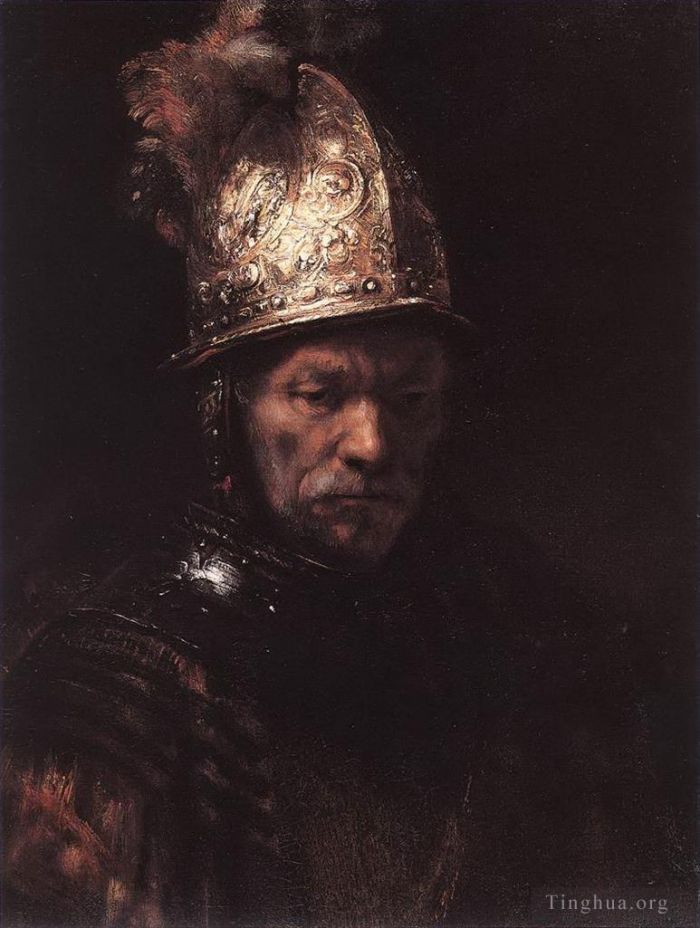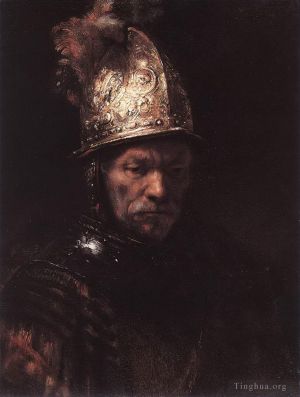The Man with the Golden Helmet
Rembrandt
- Price: Price on Request
- Art Type: Oil Painting
- Size:
- English Comments: 0
- International Comments: 0
- Creating Date:
- Introduction and Works of Rembrandt >>
Work Overview
- The Man with the Golden Helmet
Artist Circle of Rembrandt
Year c. 1650
Dimensions 67.5 cm × 50.7 cm (26.6 in × 20.0 in)
Location Gemäldegalerie, Berlin, Berlin
The Man with the Golden Helmet (c. 1650) is an oil on canvas painting formerly attributed to the Dutch painter Rembrandt and today considered to be a work by someone in his circle. It is an example of Dutch Golden Age painting and is now in the collection of the Gemäldegalerie, Berlin.
This painting was documented by Hofstede de Groot in 1915, who wrote:
"261. AN ELDERLY MAN WITH A GILT HELMET. B.-HdG. 356. He is turned a little to the right ; his eyes are cast down. He wears a dark coat with purplish-red sleeves. On his head is a richly wrought gilt helmet with ear-pieces and a plume of short white and red feathers. Dark background. Strong light falls from the left at top on tin helmet and, touching the face as it passes, on the breast. Life size, half-length. The sitter is identified as Rembrandt's brother Adriaen. But as Adriaen was a poor shoemaker in Leyden while Rembrandt lived in Amsterdam, and as moreover Adriaen van Rijn died in 1652 while this model occurs in pictures of the year 1654, the identification is not very probable. Painted about 1650. See the notes to 384 and 442 ; cf. 420, 423.
Canvas, 26 1/2 inches by 20 1/2 inches.
Exhibited at Amsterdam, 1898, No. 75.
Mentioned by Bode, Oud Holland, 1891, p. 4 ; by Dr. Laban, Zeitschrift für bildende Kunst, 1898, pp. 73, etc.
Acquired from the De Bockart collection, Fribourg, Switzerland, by the London dealers P. and D. Colnaghi ; bought from them in 1897 by the Kaiser Friedrich Museumverein, Berlin, and since exhibited--
In the Kaiser Friedrich Museum, Berlin, 1911 catalogue, No. 8llA."
Rembrandt's portrait was particularly admired by the generation of Impressionist painters as a model example of their own view of art. It has lost none of its popularity, despite commercial exploitation, although it is questionable whether this has contributed to a genuine appreciation of the picture. All too many reproductions have given the public a preconceived image of it, before actually seeing the original. It is therefore all the more necessary to try to make a detached assessment of the work.
Bode regarded the helmet as primarily an artistic end in itself. His generation, too, may have viewed the work in a more sentimental light, associating it with knights of yore and deeds of heroism. It was precisely these associations that prompted attempts to rob the unknown man with the sinister expression of his anonymity and to link him with the personal life of the painter; the theory that the man was Rembrandt's brother, Adriaen, a cobbler in Leiden, has never been substantiated.
The painting is not a portrait in the strictest sense; it was not commissioned, as so many portraits were, by prosperous Dutch citizens. The artist has captured not the splendidly armoured figure of an officer or general of his time but the tired features of an old man, who occasionally sat for him, and the gleaming splendour of an old helmet, which was part of Rembrandt's collection.
The painter's tendency to change the normal appearance of people - himself not excluded - by the use of finery and costumes is noticeable in a number of his pictures. Nevertheless, one cannot afford to neglect the motives which first inspired the artist to choose his theme, even if it offers little scope for original interpretation. Was it Rembrandt's intention to portray the unknown man as Mars? The God of War, richly helmeted, is by no means unknown as a theme in Dutch painting. The fact that such questions of interpretation are posed at all is characteristic of Rembrandt's art, in which the material and the spiritual are indissolubly linked.
Recently the attribution to Rembrandt has been questioned by both art historians and conservators.
- Copyright Statement:
All the reproduction of any forms about this work unauthorized by Singing Palette including images, texts and so on will be deemed to be violating the Copyright Laws.
To cite this webpage, please link back here.
- >> English Comments
- >> Chinese Comments
- >> French Comments
- >> German Comments
- >>Report
- Bathsheba at Her Bath
- The Return of the Prodigal Son
- Balaam and the Ass
- Stormy Landscape
- Christ driving the moneychangers from the temple 1626
- Young Man At His Desk
- Haesje
- St Paul at his WritingDesk
- The Abduction Of Ganymede
- Self Portrait at an Early Age 1628
- Woman in bed
- History Painting
- David and Uriah
- The Blinding of Samson
- Susanna
- Portrait Of Joris De Caullery
- Portrait of Nicolaes Ruts
- Flora
- Christ In The Storm On The Sea Of Galilee
- The beheading of john the baptist
- The Toilet of Bathsheba
- Susanna and the Elders
- Saskia in Pompous Dress
- Anna and the Blind Tobit
- Samson And Delilah
- Saskia Laughing
- Cupid Blowing Soap Bubbles
- Dead peacocks
- Self Portrait 1659
- The Holy Family with Angels
- The Artists Son Titus
- The denial of peter 1660
- The Baptism Of The Eunuch
- Repentant Judas Returning The Pieces Of Silver
- Portrait of the Artist at His Easel 1660
- Self Portrait as a Young Man 1634
- Young Woman Trying Earrings
- The Stoning Of St Stephen 1625
- Portrait Of An Eighty Three Year Old Woman
- Christ and the Woman Taken in Adultery
- Self-portrait as the Apostle Paul
- Musical Allegory
- The Artist In His Studio
- Maria Trip
- Man In Oriental Dress
- Titus at his desk
- Self portrait 1628
- The Polish Rider
- Agatha Bas
- Adoration of the Shepherds
- Young Man
- The Mennonite Minister Cornelis Claesz Anslo in Conversation with his Wife Aaltje
- Frederick Rihel on Horseback
- David Playing The Harp To Saul
- Portrait of Maria Trip 1639
- Portrait Of Amalia Van Solms
- Portrait Of A Young Woman With A Fan
- The holy family night
- The Elevation Of The Cross
- Jan Rijcksen And His Wife
- Holy Family
- Abraham of Isaac (The Angel Stopping Abraham from Sacrificing Isaac)
- The Mill
- The Risen Christ Appearing to Mary Magdalen
- The Ascension Of Christ
- Portrait of Saskia van Uylenburgh
- Self Portrait 1658
- Elder
- Portrait of Haesje van Cleyburgh
- Saul and David
- Landscape with the Rest on the Flight into Egypt
- The Conspiration of the Bataves
- Self portrait Det
- Portrait Of A Man
- The Holy Family
- Self
- Christ and St Mary Magdalene at the Tomb
- Joseph Accused by Potiphars Wife
- Artemisia
- Supper at Emmaus
- Christ Driving The Money Changers From The Temple
- The Prodigal Son in the Brothel (Rembrandt and Saskia in the Scene of the Prodigal Son in the Tavern)
- Sampling Officials of the DrapersGuild
- Danaë
- Winter Landscape
- Johannes
- JohDet
- Dr Ephraim Bueno Jewish Physician and Writer
- Saskia
- Self Portrait 1660
- Titus van Rijn in a Monks Habit
- Apostle Paul
- Samson at the Wedding
- St John The Baptist Preaching
- Portrait of Maria Trip
- The Night Watch
- Descent from the Cross
- Self Portrait 1669
- Portrait of Saskia with a Flower
- The Prophetess Anna known ass Mother
- The Man with the Golden Helmet
- David and Jonathan
- The Archangel Leaving the Family of Tobias
- Rape of Proserpina
- Portrait Of Maerten Soolmans
- Jeremiah Lamenting the Destruction of Jerusalem
- The Jewish Bride
- Christ on the cross 1631
- The Stone Bridge 1638
- Diana Bathing With The Stories Of Actaeon And Callisto
- Philosopher Reading
- Portrait Of A Woman
- The Anatomy Lesson of Dr Nicolaes Tulp
- Tobit and Anna with the Kid
- Peter Denouncing Christ
- Girl at a Window (Girl Leaning on a Stone Window Sill)
- The Raising of Lazarus
- Saskia Wearing A Veil
- Saskia As Flora
- The Visitation
- The Parable of the Rich Fool (The Rich Man from the Parable)
- Family Group
- Joseph Dream in the Stable in Bethlehem
- The Holy Family with a Curtain
- Deposition from the Cross
- Portrait Of An Old Man
- Self Portrait In A Gorget
- Portrait Of Alijdt Adriaensdr
- Slaughtered Ox (Flayed Ox or Side of Beef or Carcass of Beef)
- Portrait of Nicolaas van Bambeeck
- Portrait Of The Artist In A Flat Cap
- Philosopher in Meditation
- Self Portrait In A Plumed Hat
- The Incredulity of St Thomas
- Self Portrait 1629
- Self Portrait as the Apostle St Paul
- Two Old Men Disputing
- Aristotle with a Bust of Homer
- Belshazzars Feast
- Hendrickje Bathing in a River
- Portrait Of Maria Bockenolle
- Jacob
- Landscape with a Castle
- Portrait of Johannes Wtenbogaert
- Evangelist Matthew
- Self portrait 1632
- Portrait of a bearded man
- Self portrait 1640
- Jacob Blessing the Children of Joseph
- Portrait of a man in military costume
- The Dream of St Joseph
- Hendrickje Slapend RJM
- Portrait of Willem Bartholsz Ruyter
- In Velvet Cap and Plume SIL
- The Sense Of Sight
- Abraham Entertaining the Angels SIL
- Portrait of Willem Bartholsz Ruyter RJM
- Self Portrait 16289
- Sakia Asleep In Bed
- Study from the Nude Man Seated before a Curtain SIL
- The Blindness of Tobit SIL
- Drawing at a window
- Portrait Of Cornelis Claesz 1640
- Saskia In A Straw Hat
- Self Portrait Staring
- The Artists Father
- Ephraim Bonus Jewish Physician SIL









 Singing Palette
Singing Palette